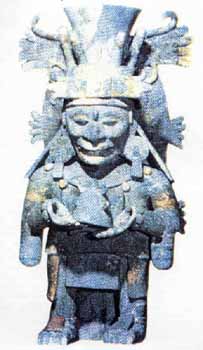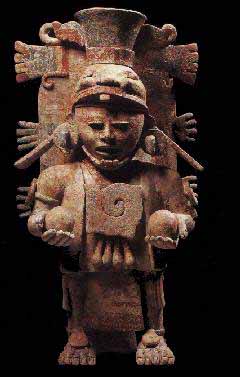The Maya are probably the best-known of the classical civilizations
of Mesoamerica. Originating in the Yucatan around 2600 B.C., they rose
to prominence around A.D. 250 in present-day southern Mexico, Guatemala,
western Honduras, El Salvador, and northern Belize.
Building on the inherited inventions and ideas of earlier civilizations such as the Olmec, the Mayans developed astronomy, calendrical systems and hieroglyphic writing. The Mayans were noted as well for elaborate and highly decorated ceremonial architecture, including temple-pyramids, palaces and observatories, all built without metal tools. They were also skilled farmers, clearing large sections of tropical rain forest and, where groundwater was scarce, building sizable underground reservoirs for the storage of rainwater. The Mayans were equally skilled as weavers and potters, and cleared routes through jungles and swamps to foster extensive trade networks with distant peoples.
Many people believe that the ancestors of the Mayans crossed the Bering Strait at least 20,000 years ago. They were nomadic hunter-gatherers. Evidence of settled habitation in Mexico is found in the Archaic period 5000-1500 BC - corn cultivation, basic pottery and stone tools.
The first true civilization was established with the rise of the Olmecs in the Pre-Classic period 1500 BC -300 AD. The Olmecs settled on the Gulf Coast, and little is known about them.
The Mayans are regarded as the inventors of many aspects of Meso-American cultures including the first calendar and hieroglyphic writing in the Western hemisphere. Archeologists have not settled the relationship between the Olmecs and the Mayans, and it is a mystery whether the Mayans were their descendants, trading partners, or had another relationship. It is agreed that the Mayans developed a complex calendar and the most elaborate form of hieroglyphics in America, both based on the Olmec's versions.

Mayans seem to have entered Yucatan from the west. As usual with ancient
nations, it is difficult in the beginning to separate myth from
history, their earliest mentioned leader and deified hero, Itzamn‡,
being considered to be simply a sun-god common to the Mayan
civilization. He is represented as having led the first migration from
the Far East, beyond the ocean, along a pathway miraculously opened
through the waters.

The second migration, which seems to have been historic, was led from
the west by Kukulcan, a miraculous priest and teacher, who became the
founder of the Mayan kingdom and civilization. Fairly good authority,
based upon study of the Mayans chronicles and calendar, places this
beginning near the close of the second century of the Christian Era.
Under Kukulcan the people were divided into four tribes, ruled by as many kingly families: the Cocom, Tutul-xiu, Itz‡ and Chele.
To the first family belonged Kukulcan himself, who established his residence at Mayanspan, which thus became the capital of the whole nation. The Tutul-xiu held vassal rule at Uxmal, the Itz‡ at Chichen-Itz‡, and the ChelŽ at Izamal.
To the Chele was appointed the hereditary high priesthood, and their city became the sacred city of the Mayans. Each provincial king was obliged to spend a part of each year with the monarch at Mayapan. This condition continued down to about the eleventh century, when, as the result of a successful revolt of the provincial kings, Mayapan was destroyed, and the supreme rule passed to the Tutul-xiu at Uxmal.
Later on Mayapan was rebuilt and was again the capital of the nation until about the middle of the fifteenth century, when, in consequence of a general revolt against the reigning dynasty, it was finally destroyed, and the monarchy was split up into a number of independent petty states, of which eighteen existed on the peninsula at the arrival of the Spaniards.
In consequence of this civil war a part of the Itz‡ emigrated south to Lake PetŽn, in Guatemala, where they established a kingdom with their capital and sacred city of Flores Island in the lake.
Building on the inherited inventions and ideas of earlier civilizations such as the Olmec, the Mayans developed astronomy, calendrical systems and hieroglyphic writing. The Mayans were noted as well for elaborate and highly decorated ceremonial architecture, including temple-pyramids, palaces and observatories, all built without metal tools. They were also skilled farmers, clearing large sections of tropical rain forest and, where groundwater was scarce, building sizable underground reservoirs for the storage of rainwater. The Mayans were equally skilled as weavers and potters, and cleared routes through jungles and swamps to foster extensive trade networks with distant peoples.
Many people believe that the ancestors of the Mayans crossed the Bering Strait at least 20,000 years ago. They were nomadic hunter-gatherers. Evidence of settled habitation in Mexico is found in the Archaic period 5000-1500 BC - corn cultivation, basic pottery and stone tools.
The first true civilization was established with the rise of the Olmecs in the Pre-Classic period 1500 BC -300 AD. The Olmecs settled on the Gulf Coast, and little is known about them.
The Mayans are regarded as the inventors of many aspects of Meso-American cultures including the first calendar and hieroglyphic writing in the Western hemisphere. Archeologists have not settled the relationship between the Olmecs and the Mayans, and it is a mystery whether the Mayans were their descendants, trading partners, or had another relationship. It is agreed that the Mayans developed a complex calendar and the most elaborate form of hieroglyphics in America, both based on the Olmec's versions.


Under Kukulcan the people were divided into four tribes, ruled by as many kingly families: the Cocom, Tutul-xiu, Itz‡ and Chele.
To the first family belonged Kukulcan himself, who established his residence at Mayanspan, which thus became the capital of the whole nation. The Tutul-xiu held vassal rule at Uxmal, the Itz‡ at Chichen-Itz‡, and the ChelŽ at Izamal.
To the Chele was appointed the hereditary high priesthood, and their city became the sacred city of the Mayans. Each provincial king was obliged to spend a part of each year with the monarch at Mayapan. This condition continued down to about the eleventh century, when, as the result of a successful revolt of the provincial kings, Mayapan was destroyed, and the supreme rule passed to the Tutul-xiu at Uxmal.
Later on Mayapan was rebuilt and was again the capital of the nation until about the middle of the fifteenth century, when, in consequence of a general revolt against the reigning dynasty, it was finally destroyed, and the monarchy was split up into a number of independent petty states, of which eighteen existed on the peninsula at the arrival of the Spaniards.
In consequence of this civil war a part of the Itz‡ emigrated south to Lake PetŽn, in Guatemala, where they established a kingdom with their capital and sacred city of Flores Island in the lake.
No comments:
Post a Comment